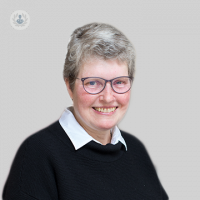The menopause - moving on to a new chapter in a woman’s life
Written in association with:The menopause usually occurs in a woman’s middle age, when her periods stop. It brings a number of physical and emotional changes. As women live longer, management of the menopause is important to enhance quality of life and minimise the effects of prolonged low oestrogen levels. Consultant community gynaecologist Miss Christine Robinson offers her insight into the menopause:

Different terms associated with the menopause
- The menopause itself is when the last natural period (LNP) has occurred, usually at about age 51. At this time ovarian hormone production has fallen dramatically, but rarely, ovulation can occur. Contraception is advised for one year after the last period if the patient is over 50, or two years if under 50.
- Premature menopause is when the LNP occurs under age 45, although those under 40 may have premature ovarian insufficiency (POI). Ovarian damage, e.g. by chemotherapy, radiotherapy, or surgical removal can induce the menopause.
- Post menopause is defined as 12 months or more from the LNP.
- Symptoms start in the perimenopause, i.e. the time leading up to the LNP, and for one year after it. Most suffer with some mix of menstrual changes, hot flushes and sweats, vaginal dryness, low mood or sexual difficulties, but there may be other symptoms. On average, hot flushes and sweats last seven years.
Diagnosis of the menopause is based on age and symptomology for women over 45. Blood follicle stimulating hormone (FSH) is needed for women under 45 and further tests are needed if POI (premature ovarian insufficiency) is suspected.
Menopause treatments
Hormone Replacement Therapy (HRT) is the most effective treatment for symptoms and has longer-term benefits, such as maintenance of bone strength. It usually incorporates oestrogen and progesterone, and is available in different forms, e.g. patches, gels, tablets, pessaries and hormonal coils. Oestrogen can be applied topically to the vagina to relieve dryness. It is important to spend time with each patient, listening to concerns and questions. A review of medical and family history is vital. The gynaecologist should go through the benefits and risks of HRT, enabling and supporting each patient to make a plan for her path through the menopause in an informed way. For many, the benefits of HRT outweigh the risks, but not for all.

Women take HRT to relieve symptoms and for longer-term health benefits, e.g. osteoporosis prevention.
Current thinking is that cardiovascular problems may not be as much of a contraindication to HRT as previously thought, thus opening up access to HRT for more women. The risk of breast cancer in patients taking HRT with oestrogen and progesterone goes up with length of use, and gradually reduces after stopping. If using oestrogen alone, there is probably no increased risk. Whatever path is chosen by the patient, support and monitoring (e.g. mammography) should be put in place. Patients should preferably be seen three months after starting to take HRT, and if all is well, less often thereafter, but always with an open door if issues occur.
with an open door if issues occur.
Non-hormonal prescription preparations can help, e.g. venlafaxine for hot flushes. Other therapies have some effect, e.g. red leaf clover, but their safety profile is still under review. CBT may also help.
Lifestyle changes, such as a healthy diet, stopping smoking, cutting down on caffeine, and increasing exercise can help.
Menopause management must be individualised and personalised. It should be delivered in an inclusive, empathetic and supportive way, by an expert in menopause medicine and contraception, so that the contraceptive aspect of the menopausal transition is seamlessly incorporated.


